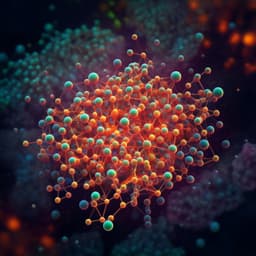
Medicine and Health
Combining p53 mRNA nanotherapy with immune checkpoint blockade reprograms the immune microenvironment for effective cancer therapy
Y. Xiao, J. Chen, et al.
Discover how restoring p53 expression can transform the immunosuppressive tumor microenvironment in hepatocellular carcinoma. This research demonstrates the powerful synergy of p53 mRNA nanomedicine combined with immune checkpoint blockade therapy, leading to enhanced antitumor effects. A team of experts, including Yuling Xiao and Jiang Chen, conducted this groundbreaking study.
~3 min • Beginner • English
Introduction
The study addresses why immune checkpoint blockade (ICB) yields limited benefit in hepatocellular carcinoma (HCC), focusing on immunosuppression within the tumor microenvironment (TME) and the frequent loss of p53 function in HCC. p53 regulates cell cycle arrest, apoptosis, senescence, and also modulates antitumor immunity by regulating cytokines, chemokines, pathogen recognition receptors, NK cell ligands, and macrophage polarization. Given evidence that p53 dysfunction contributes to immunoediting and immune evasion, the authors hypothesize that restoring p53 expression in HCC tumor cells could reprogram the immune TME and enhance responsiveness to ICB. The purpose is to develop a CXCR4-targeted p53 mRNA nanoparticle (NP) platform, evaluate its targeting and therapeutic efficacy, and determine whether combining p53 restoration with PD-1 blockade can improve antitumor immunity and outcomes in p53-deficient HCC models.
Literature Review
Prior work shows p53 influences immune responses through transcriptional regulation of cytokines (e.g., TNF-α, IL-12, IL-15), chemokines (e.g., CCL2/20/28, CXCL1/2/3/5/8), and TLRs, enhancing adaptive immunity, NK cell-mediated tumor cell killing via NKG2D ligands, and suppressing pro-tumor M2-like TAM polarization. Immunogenic cell death can synergize with p53 pathway activation. Combinations of ICB with other agents (e.g., anti-VEGF) improved efficacy in models and clinical trials, but many HCC patients remain non-responders, underscoring the need for novel combinations. Reactivating p53 via small molecules or DNA approaches is under exploration; mRNA offers advantages (no genomic integration, direct translation). This study builds on these findings by testing targeted mRNA delivery to restore p53 in HCC and potentiate ICB.
Methodology
- Nanoparticle design and synthesis: Developed polymer–lipid hybrid mRNA nanoparticles composed of a biodegradable lipid-like ionizable component (Go-C series; Go-C8 selected after screening), a PLGA core, and a lipid-PEG shell. CXCR4 targeting was achieved by conjugating CTCE-9908 peptide to DSPE-PEG-Mal via thiol–maleimide chemistry (yield ~82%; confirmed by 1H-NMR). A scrambled peptide (SCP) was used for non-targeted controls. Optimal CTCE surface density (~5%) maximized RIL-175 cell uptake while maintaining stability.
- Physicochemical characterization: Targeted CTCE-p53 mRNA NPs were spherical, uniform, ~110 nm by DLS; similar size/zeta to control formulations. TEM confirmed morphology. Formulations with luciferase and EGFP mRNA were also characterized. Stability: particle size unchanged over 10 days; serum incubation (10%) up to 96 h did not affect viability; mRNA integrity preserved in DMF.
- mRNA complexation optimization: pH-dependent complexation with Go-C8; efficient complexation/decomplexation at acidic pH (citrate buffer pH ~3.5) allowing low Go-C8:mRNA ratios (as low as 2:1 by weight). Agarose gels assessed complexation/release. Cytotoxicity assays showed ~100% viability across broad Go-C8:mRNA dose ranges in RIL-175 and Huh-7 cells.
- Cell lines: p53-null murine HCC RIL-175 (C57BL/6 background) as primary model; p53-wildtype murine HCC HCA-1 (C3H background) for comparison.
- Target validation: Generated CXCR4-knockout RIL-175 via CRISPR/Cas9 to test targeting specificity; observed reduced uptake of CTCE-labeled mRNA NPs in CXCR4-KO versus control cells (flow cytometry/confocal).
- In vitro uptake and expression: Confocal time-course with Cy5-labeled mRNA NPs (0–6 h). Western blot and immunofluorescence confirmed higher p53 protein expression with CTCE-p53 NPs vs SCP-p53 NPs in RIL-175; p53 localized mainly in cytoplasm. Viability and long-term growth assays assessed dose-dependent cytotoxicity and growth inhibition after CTCE-p53 NPs vs controls.
- Pharmacokinetics and biodistribution: C57BL/6 mice received 350 µg/kg Cy5-Luc mRNA (free) or as SCP/CTCE NPs i.v. via tail vein. Blood sampling up to 4 h: free mRNA rapidly cleared (~8% at 15 min; mostly cleared by 1 h); both NP types prolonged circulation (~<30% at 60 min, ~20% at 4 h). Biodistribution at 24 h in orthotopic and ectopic RIL-175 models showed significantly higher tumor accumulation for CTCE-targeted versus non-targeted NPs (~1.25–2× increase); free mRNA minimally detected.
- In vivo efficacy (orthotopic model): Established orthotopic RIL-175 tumors in C57BL/6 mice. Treatment groups: saline/IgG control; CTCE-EGFP NPs; CTCE-p53 NPs (p53 mRNA 350 µg/kg i.v.); anti-PD-1 (aPD1) 10 mg/kg i.p.; combination CTCE-p53 NPs + aPD1. Dosing every 3 days for four cycles. Tumor growth monitored by high-frequency ultrasound; p53 expression verified by IHC.
- Immune profiling: Post-treatment flow cytometry of dissociated tumors assessing CD8+ T cell infiltration and activation (IFN-γ+ TNF-α+), NK cell activation (CD107a, IFN-γ, IFN-γR), and TAM polarization (M1 vs M2 markers). Cytokine profiling by multiplex/protein arrays from tumor lysates (TNF-α, IL-1β, IFN-γ, IL-2, IL-6, MCP-1/CCL2).
- Ectopic model: Subcutaneous RIL-175 tumors treated analogously; bioluminescence imaging, growth rates, immune infiltrates (CD8 T cells, DCs, M2 macrophages) and cytokines assessed; p53 expression by Western blotting and CD8 IF/IHC.
- Survival and metastasis: Orthotopic model survival study with the same dosing. Assessed median overall survival, ascites, pleural effusions, and counted lung metastatic nodules.
- Comparator regimen: Side-by-side survival comparison of CTCE-p53 NPs + aPD1 versus anti-VEGF + aPD1 combination (a clinical standard-like regimen) in orthotopic RIL-175.
- p53-WT model: Tested CTCE-p53 NPs + aPD1 in orthotopic HCA-1; in vitro showed modest cytotoxicity; in vivo no survival benefit at the same dosing schedule.
- Safety assessments: Body and organ weights; complete blood counts and chemistries (ALT, AST, total protein, RBC, WBC, Hb, MCHC, MCH, HCT, lymphocytes); H&E histology of major organs. No significant abnormalities observed across treatment groups.
Key Findings
- Targeted delivery and expression: CTCE-conjugated mRNA NPs achieved higher cellular uptake in CXCR4+ RIL-175 cells compared with SCP controls, abrogated by CXCR4 knockout. In vivo, CTCE-targeted NPs exhibited ~1.25–2× higher intratumoral accumulation than non-targeted NPs; free mRNA was rapidly cleared and showed minimal tumor delivery.
- PK: Free Cy5-mRNA declined to ~8% by 15 min and was largely undetectable by 1 h, whereas both CTCE and SCP NPs retained ~<30% at 60 min and ~20% at 4 h post-injection.
- p53 restoration and cytotoxicity: CTCE-p53 NPs induced higher p53 protein expression (WB/IF) than SCP-p53 NPs in RIL-175 and decreased viability in a dose-dependent manner; long-term culture showed marked growth inhibition relative to controls.
- Orthotopic efficacy: CTCE-p53 NPs or aPD1 alone reduced tumor growth versus control, but the combination significantly outperformed either monotherapy in suppressing growth (ultrasound imaging) and reducing tumor weight. IHC confirmed robust tumor p53 expression in NP-treated groups.
- Immune reprogramming: Combination therapy significantly increased tumor-infiltrating CD8+ T cells and the fraction of activated IFN-γ+ TNF-α+ CD8+ T cells. It enhanced NK cell activation (e.g., CD107a+, IFN-γ+, IFN-γR+ subsets). TAMs shifted toward M1-like and away from M2-like phenotypes. Cytokine analyses showed significant increases in TNF-α and IL-1β, trends toward increased IFN-γ and IL-2, and reduced IL-6, with little change in MCP-1/CCL2.
- Survival and metastasis: In the orthotopic RIL-175 model, CTCE-p53 NPs + aPD1 extended median overall survival to 43.5 days (approximately double the control; HR = 0.26; p = 0.0001), reduced incidence of bloody ascites and pleural effusions, and significantly decreased the number of lung metastases. The CTCE-p53 NPs + aPD1 regimen showed survival benefit comparable to anti-VEGF + aPD1.
- p53 dependence: In p53-wildtype HCA-1, CTCE-p53 NPs showed modest in vitro cytotoxicity but did not improve in vivo survival at the tested dosing, suggesting the benefit is specific to p53-deficient tumors.
- Safety: No significant changes in body/organ weights, blood chemistries, hematology, or organ histopathology across treatment groups, indicating favorable tolerability.
Discussion
Restoring p53 in tumor cells via CXCR4-targeted mRNA nanoparticles effectively reverses multiple facets of HCC immunosuppression, enhancing infiltration and activation of CD8+ T cells and NK cells and repolarizing TAMs toward an antitumor phenotype. These changes sensitize p53-deficient HCC to PD-1 blockade, resulting in significantly improved tumor control, reduced metastatic spread and effusions, and prolonged survival. The targeted mRNA platform ensures efficient delivery and expression without genomic integration risk, addressing challenges of prior p53 reactivation strategies. The comparable survival benefit to anti-VEGF + aPD1 underscores clinical relevance, while the lack of benefit in p53-WT tumors highlights mechanistic specificity and a potential biomarker for patient selection. Collectively, the findings support combining p53 mRNA restoration with ICB to convert immunologically cold HCC into responsive tumors.
Conclusion
The study presents a CXCR4-targeted p53 mRNA nanoparticle platform that restores p53 function in p53-deficient HCC, reprograms the immune microenvironment, and markedly enhances the efficacy of PD-1 blockade. The combination yields superior tumor control, survival extension, and decreased ascites, pleural effusions, and lung metastases, with a favorable safety profile. This mRNA nanotherapy approach offers a promising and potentially generalizable strategy for p53-deficient cancers. Future work should elucidate how distinct p53 alterations in cancer cells shape the immune TME, characterize effects on immune cell subsets in vivo, optimize durability by integrating additional agents (e.g., VEGF blockade), and advance translational development toward clinical trials with biomarker-driven patient selection.
Limitations
- Preclinical murine models: Findings may not fully translate to humans; humanized models and clinical trials are needed.
- p53 status dependency: Efficacy was demonstrated in p53-null tumors; no survival benefit was observed in a p53-wildtype HCA-1 model at the same dosing, indicating limited applicability to p53-proficient tumors.
- Limited long-term safety: While short-term hematology, chemistry, and histology were favorable, long-term toxicity, immunogenicity of repeated dosing, and off-target effects require further evaluation.
- Heterogeneity of HCC and TME: The study used specific syngeneic models; broader testing across diverse HCC genotypes/phenotypes and microenvironments is warranted.
- Mechanistic depth: Although immune reprogramming was documented, detailed molecular pathways linking p53 restoration to specific immune changes (e.g., antigen presentation dynamics, myeloid subsets) remain to be fully delineated.
Related Publications
Explore these studies to deepen your understanding of the subject.







